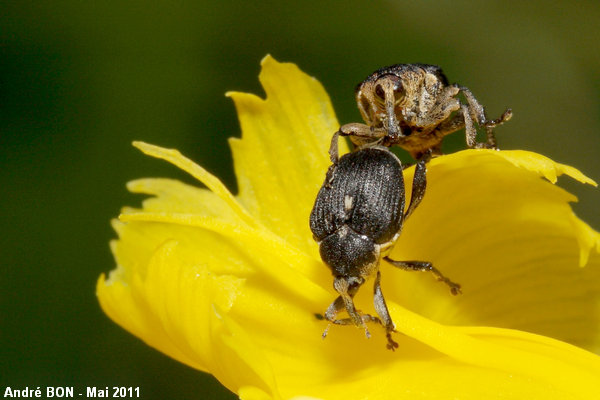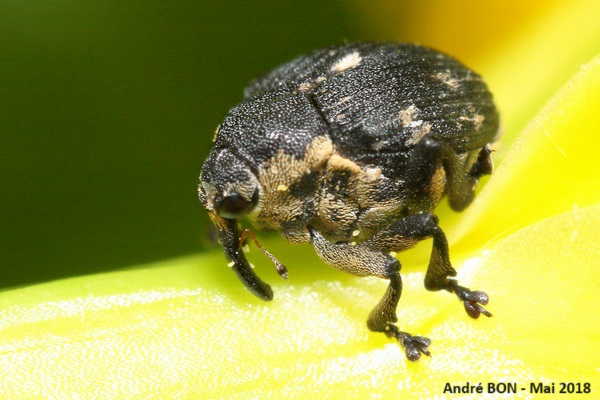




| Iris Seed Weevil (Mononychus punctumalbum (Herbst, 1784)) |





|
|
Scientific name: Mononychus punctumalbum (Herbst, 1784) Common name: Iris Seed Weevil Other names: Other scientific names: Mononychus pseudacori, Mononychus salviae. French name: Charançon de l'Iris des marais Order: Coleoptera Family: Curculionidae Wingspan : 4-4,2 mm. Biotope: Vegetation near water, on or near Iris (mainly on Yellow Iris Iris pseudacorus). Sometimes in dryer places on cultivated Iris. Geographic area: All Europe, missing in Scandinavia. Observation period : Adults appear in May on Iris flowers. Females lay the eggs inside the fruit capsules and the larval development is rather fast. The new generation emerges between late July and early September depending of the region. These new weevils hide under the litter where they are difficult to observe. They over winter down there before climbing back on Iris flowers in May of the following year. |
The Iris Seed Weevil is a small coleoptera which shows one black form and one pale brown form. These two forms of the same species, which can live at the same place, have been erroneously considered as two different species. The under side of the body, the lateral sides of the prothorax and part of the head show a yellowish pilosity. There is one pure white spot, on the suture at the front of the elytra at the back of the scutellum. The strongly curved roster is as long as the prothorax. The antennae are russet with a black tip. The tarsi only show one claw (this is the meaning of the name of the genus). Though its rounded look, this weevil can fly very easily. |
| [To know more about the Iris Seed Weevil] [Next picture] [Top] |

|
I had many difficulties to take pictures of all these tiny weevils because of their mobility. And they are very fast to fly away when you get too close. However I will come back to shoot pictures these following years because they are rather photogenic and easy to find on Iris flowers. |
| [To know more about the Iris Seed Weevil] [Next picture] [Previous picture] [Top] |

|
I am missing a nice side view to better see the roster. |
| [To know more about the Iris Seed Weevil] [Next picture] [Previous picture] [Top] |

|
I have a small pond with Iris in my garden. I am quite attentive to what is happening there and after many years of observation this is the first time that I have seen an Iris Seed Weevil there. |
| [To know more about the Iris Seed Weevil] [Next picture] [Previous picture] [Top] |

|
I thought of the Iris Seed Weevil when I photographed this specimen. However, seeing it on a Poppy points more towards the Stenocarus genus. As I do not see the black patch characteristic of the genus near the scutellum (next photo), I stick with the subfamily. |
| [To know more about the Iris Seed Weevil] [Previous picture] [Top] |

|
This top view can perhaps provide useful information, shape of the pronotum, constriction between the edges of the pronotum and the elytra, etc. However, I am not competent/experienced enough to use them. |